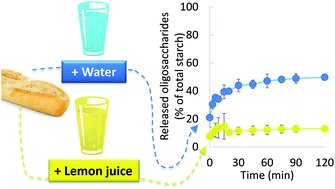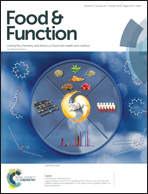Acid induced reduction of the glycaemic response to starch-rich foods: the salivary α-amylase inhibition hypothesis
Abstract
Numerous studies have reported that the glycaemic response to starch-rich meals can be reduced by 20–50% with acidic drinks or foods. A number of candidate explanations have been put forward, but this phenomenon still remains vaguely understood. This study intends to demonstrate the remarkable effect of acid inhibition of salivary α-amylase during oro-gastric hydrolysis of starch, shedding light on this often overlooked mechanism. Oro-gastric digestions of bread, wheat and gluten-free pastas, combined with either water or lemon juice were performed using a dynamic in vitro system that reproduces gastric acidification kinetics observed in humans. In the presence of water, large proportions of starch (25–85%) and oligosaccharides (15–50%) were released from all foods within the first hour of gastric digestion (pH > 3.5). In the presence of lemon juice (pH < 3.5 at all time), starch release was about twice as low, and amylolysis into oligosaccharides was completely interrupted. Acid-inhibition of salivary α-amylase may explain, at least in part, the reduction of the blood glucose response through acidification of starch-rich foods/meals. This offers new perspectives for the development of strategies to improve the glycaemic response elicited by starch-rich diets.



 Please wait while we load your content...
Please wait while we load your content...